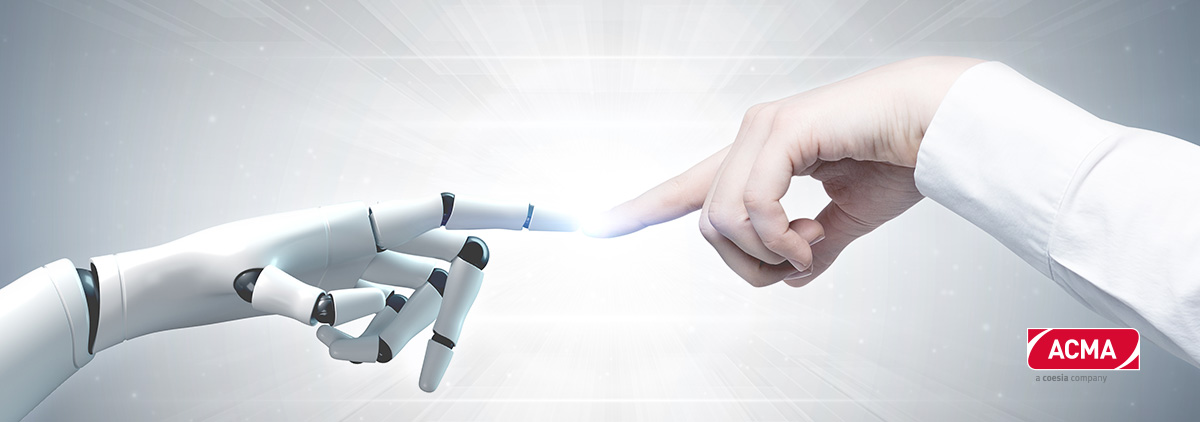INDUSTRY 4.0: from digital intelligence to machine learning – the ongoing revolution
Contents of the article
1. THE BUILDING BLOCKS OF INDUSTRY 4.0
2. HOW COESIA & ACMA ADDRESSING THE NEEDS OF THEIR CUSTOMERS
The digitalization process can be found in more and more aspects of daily life, from building automation to vehicle safety systems.
In Business, the Industry 4.0 revolution is gradually modifying the production processes for numerous industrial sectors and organizations.
Behind the so-called fourth industrial revolution lies the concept of the smart factory. This refers to highly digitized and connected production facilities that rely on the digitalization of manufacturing processes.
The most advanced digital technologies allow production processes to be progressively transformed. This is made possible by the introduction of machines that are capable of working more efficiently, more collaboratively and more resiliently compared to the past.
According to a study carried out by The Boston Consulting Group [1] nine technology trends are transforming production systems based on the principles of industry 4.0 in the manufacturing sector
- big data and analytics
- autonomous robots
- simulation systems
- horizontal and vertical system integration
- the industrial Internet of Things (IoT)
- cybersecurity
- the cloud
- additive manufacturing
- augmented reality
These will lead to greater efficiencies and change traditional production relationships between suppliers, producers, and customers. Big data and analytics and the industrial IoT are shaping the fourth industrial revolution and will inevitably shape the B2B sector.
The building blocks of industry 4.0
At the base of this revolution, there are interconnected phases and technological innovation processes that are able to implement production automation and make it effective.
At the beginning of this process is the industrial IoT (Internet of Things), which allows equipment and systems to be connected on a network and for data to be extracted in order to monitor and control the machines and processes.
Once this process has started, Digital Intelligence makes it possible to compile and correlate the data - acquired from the network-connected machines - for the purpose of carrying out predictive analysis.
Machine learning is the last step towards complete digital transformation. By implementing mathematical models and algorithms, machines are able to analyze the data automatically. This means that the optimization of production processes - without the need for human intervention - becomes reality.
The industrial Internet of Things (IoT)
When it comes to manufacturing facilities, the purpose of the industrial IoT is essentially to connect production equipment, thereby allowing information to be shared between the connected machines. This connection is allows data to be collected for monitoring and controlling production.
Machine to machine (M2M) communication helps to speed up processes in industrial plant. Effective data collection is the starting point for improving machine performance, since it is the first building block for rapid access to production-related information. Combined with data analysis, this helps to identify any critical issues that might arise on the machines.
Digital intelligence
As far as production is concerned, digital intelligence and machine learning are mutually integrated principles that aim to optimize the efficiency of machines.
In particular, digital intelligence focuses on analyzing production data – acquired thanks to IoT - and creating models that are capable of addressing future production issues. After having compiled the data, statistical models can be applied in order to gain insight into production performance. Because of the mathematical relationship between the condition of the machine and the probability of the occurrence of an event, digital intelligence transforms the analysis from inductive to predictive, thereby extending the time horizon of information from the present to the future.
One of the most concrete advantages of digital intelligence is predictive analytics, which makes it possible to understand machine behaviour in advance and plan the necessary measures to be applied to prevent malfunctions and emergencies.
While the IoT compiles the production-related data from the machines (for instance alarms), the application of statistical models connected to machine intelligence allows the information to be interpreted. For example, digital intelligence not only makes it possible to understand the cause of machine alarms, but it can also assist the operators by providing messages and information about how to solve problems and avoid unscheduled stoppages.
Machine learning
Machine learning stems from the notion that we should be able to give machines access to data and allow them to learn independently.
The combination of network-connected machine data and the application of digital intelligence are the key elements of machine learning. Once performance insights are generated and shared with the machines themselves, through the application of self-learning algorithms, production equipment can start to learn from its own behaviour and self-adapt accordingly.
Machine learning implies exploratory data analysis, i.e. using statistical techniques and algorithms to apply predictive analytics, clustering and forecasting using the information extracted from the data. The advantages of machine learning are:
- Identifying trends and production patterns
- Making human intervention unnecessary
- Allowing continuous improvement
- Handling multidimensional data
This open up new knowledge scenarios for companies, to analyze and manage a forward-looking business in order to ensure increased efficiency and competitiveness.
How Coesia & ACMA addressing the needs of their customers
To keep offering customers cutting-edge products and services, Coesia is exploring the fields of connectivity, big data analytics, line and machine intelligence, digital-to-physical conversion, robotics and artificial intelligence, while at the same time prioritizing cybersecurity.
In order to boost the digital transformation strategy and develop stronger partnerships with customers and suppliers, Coesia has set up a multi-functional team to leverage internal strengths and synergies to ensure that customers’ needs are fulfilled through state-of-the-art innovations.
Together with the Coesia Digital team, ACMA is speeding up digital innovation in data collection and analysis to offer its customers improved performance and efficiency optimization.
For example, starting from tea-bag packing machines, ACMA is developing digital applications that will able to collect, analyze, and process data in real time, focusing on critical processes in order to improve production quality and avoid machine stoppages.
Advanced WebHMI
ACMA is also leading innovation when it comes to human-machine interface panels: advanced HMIs represent the evolution of machine management systems.
ACMA’s advanced HMI is an excellent example of where Industry 4.0 moves from a theoretical to an operational level. An intuitive interface and embedded web connectivity make ACMA’ WebHMIs collaborative production devices that allow the operator to interact more easily with the machine.
The practical user experience design and the usability of the WebHMI simplifies the daily tasks of the operators, which has a positive impact on time management.
It is essential for successful companies to foster digital innovation. ACMA is no exception and is already working on two areas for its customers:
- Enhancement of the way information is accessed and exchanged, allowing customers to engage wherever and whenever it is convenient for them. Services include digital documentation, video tutorials for training and access to the spare parts portal.
- Innovation, to support customers’ pursuit of improved performance, by providing outstanding products and services that innovate the way of interacting with machines. Examples are digital assisted guided procedures and digital trouble-shooting procedures.
Learn more about our solutions
CONTACT OUR SPECIALISTS



